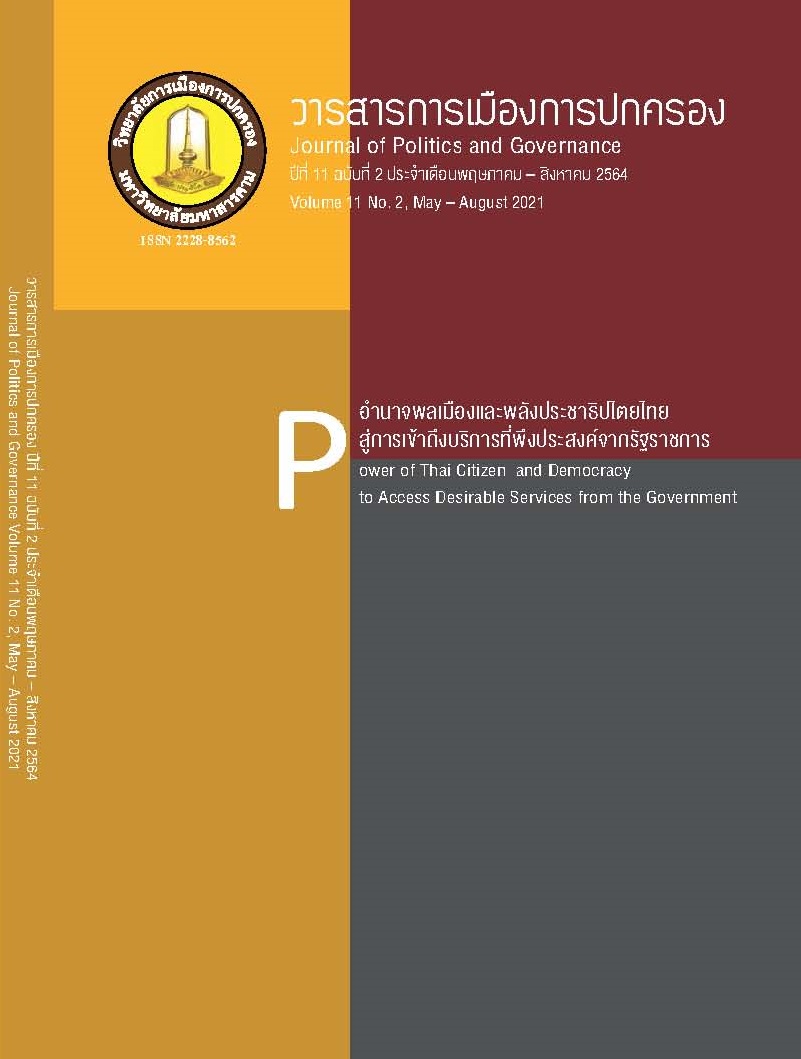The Effect of Authentic Leadership (AL) and Individual Innovation Adoption (IA) on Innovative Work Behavior (IWB) in Thai Context
Main Article Content
Abstract
The objective of this study was to examine the effect of Authentic Leadership (AL) on Innovative Work Behavior (IWB) with a consideration on the moderating effect of Innovation Adoption (IA) on that effect. Data analysis using structural equation modeling (SEM) supported the hypothesis that authentic leadership and innovation adoption had positive effects on innovative work behavior. However, the results did not demonstrate the moderating effect of innovation adoption but indicated the interrelated effect of innovation adoption and authentic leadership on innovative work behavior. The size of the corporation and corporate core values (such as creativity and innovation) might undermine the moderating effect of innovation adoption. Future research should study small or diverse business companies with and without innovation embedded in their corporate core values. The innovation adoption questionnaire should also be used in other sectors or countries to test the generality of the questionnaire.
Article Details
References
Ajzen, I. (1991). The theory of planned behavior. Organizational behavior and human decision processes, 50(2), 179-211.
Amornpipat, I. (2016). The Development of Authentic Leadership Measure and Its Validation on Follower’s Wellbeing and Innovative Work Behaviour in The Thai Context. (Doctor of Philosophy). National Institute of Development Administration, National Institute of Development Administration.
Avolio, B. J., & Gardner, W. L. (2005). Authentic leadership development: Getting to the root of positive forms of leadership. The leadership quarterly, 16(3), 315-338.
Avolio, B. J., Gardner, W. L., & Walumbwa, F. O. (2007). Authentic leadership questionnaire. Retrieved February, 2, 2009.
Avolio, B. J., Gardner, W. L., Walumbwa, F. O., Luthans, F., & May, D. R. (2004). Unlocking the mask: A look at the process by which authentic leaders impact follower attitudes and behaviors. The leadership quarterly, 15(6), 801-823.
Basadur, M. (2004). Leading others to think innovatively together: Creative leadership. The leadership quarterly, 15(1), 103-121.
Butler, D. L., & Sellbom, M. (2002). Barriers to adopting technology. Educause Quarterly, 2(1), 22-28.
Carayannis, E. G., Meissner, D., & Edelkina, A. (2017). Targeted innovation policy and practice intelligence (TIP2E): concepts and implications for theory, policy and practice. The Journal of Technology Transfer, 42(3), 460-484.
Černe, M., Jaklič, M., & Škerlavaj, M. (2013). Authentic leadership, creativity, and innovation: A multilevel perspective. Leadership, 9(1), 63-85.
Daft, R. L. (1978). A dual-core model of organizational innovation. Academy of management Journal, 21(2), 193-210.
Damanpour, F., & Wischnevsky, J. D. (2006). Research on innovation in organizations: Distinguishing innovation-generating from innovation-adopting organizations. Journal of engineering and technology management, 23(4), 269-291.
De Jong, J. P., & Den Hartog, D. N. (2008). Innovative work behavior: Measurement and validation. EIM Business and Policy Research, 1-27.
Farr, J. L., & Ford, C. M. (1990). Individual innovation.
Howell, J. M., Shea, C. M., & Higgins, C. A. (2005). Champions of product innovations: defining, developing, and validating a measure of champion behavior. Journal of business venturing, 20(5), 641-661.
Kanter, R. M. (1988). Three tiers for innovation research. Communication Research, 15(5), 509-523.
Koen, V., Asada, H., Rahuman, M. R. H., & Bogiatzis, A. (2018). Boosting productivity and living standards in Thailand.
Krejcie, R. V., & Morgan, D. W. (1970). Determining sample size for research activities. Educational and psychological measurement, 30(3), 607-610.
Le Bon, J., & Merunka, D. (1998). The role of attitude in competitive intelligence activities of salespersons: evidence and consequences of the mediating effect. ISBM report, 22.
Lee, G., & Xia, W. (2006). Organizational size and IT innovation adoption: A meta-analysis. Information & management, 43(8), 975-985.
McGuirk, H., Lenihan, H., & Hart, M. (2015). Measuring the impact of innovative human capital on small firms’ propensity to innovate. Research Policy, 44(4), 965-976.
Müceldili, B., Turan, H., & Erdil, O. (2013). The influence of authentic leadership on creativity and innovativeness. Procedia-Social and Behavioral Sciences, 99, 673-681.
OECD. (2012). Innovation for Development. Retrieved from https://www.oecd.org/innovation/inno/50586251.pdf
Oke, A., Munshi, N., & Walumbwa, F. O. (2009). The influence of leadership on innovation processes and activities. Organizational Dynamics, 38(1), 64-72.
Oldham, G. R., & Cummings, A. (1996). Employee creativity: Personal and contextual factors at work. Academy of management Journal, 39(3), 607-634.
Rogers, E. M. (1995). Diffusion of Innovations: modifications of a model for telecommunications. In Die diffusion von innovationen in der telekommunikation (pp. 25-38): Springer.
Rogers, E. M., & Shoemaker, F. F. (1971). Communication of Innovations; A Cross-Cultural Approach.
Scott, S. G., & Bruce, R. A. (1994). Determinants of innovative behavior: A path model of individual innovation in the workplace. Academy of management Journal, 37(3), 580-607.
Talukder, M., Harris, H., & Mapunda, G. (2008). Adoption of innovations by individuals within organizations: An Australian study. Asia Pacific Management Review, 13(2), 463-480.
Walumbwa, F. O., Avolio, B. J., Gardner, W. L., Wernsing, T. S., & Peterson, S. J. (2008). Authentic leadership: Development and validation of a theory-based measure. Journal of management, 34(1), 89-126. . Chulalongkorn University.
Wells, J. D., Campbell, D. E., Valacich, J. S., & Featherman, M. (2010). The effect of perceived novelty on the adoption of information technology innovations: a risk/reward perspective. Decision sciences, 41(4), 813-843.
Wongwanich, S., & Wiratchai, N. (2003). Guidelines for Thesis Consultant: Research and Educational Psychology Department, Faculty of Education. Chulalongkorn University.


